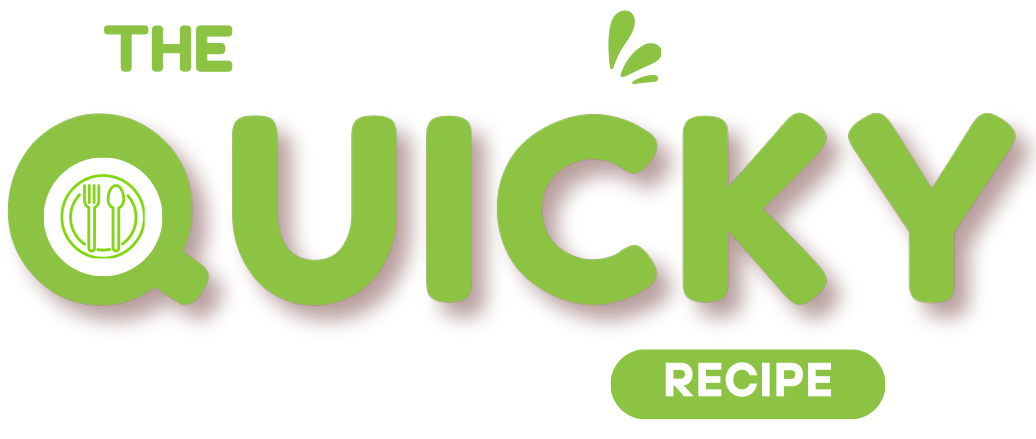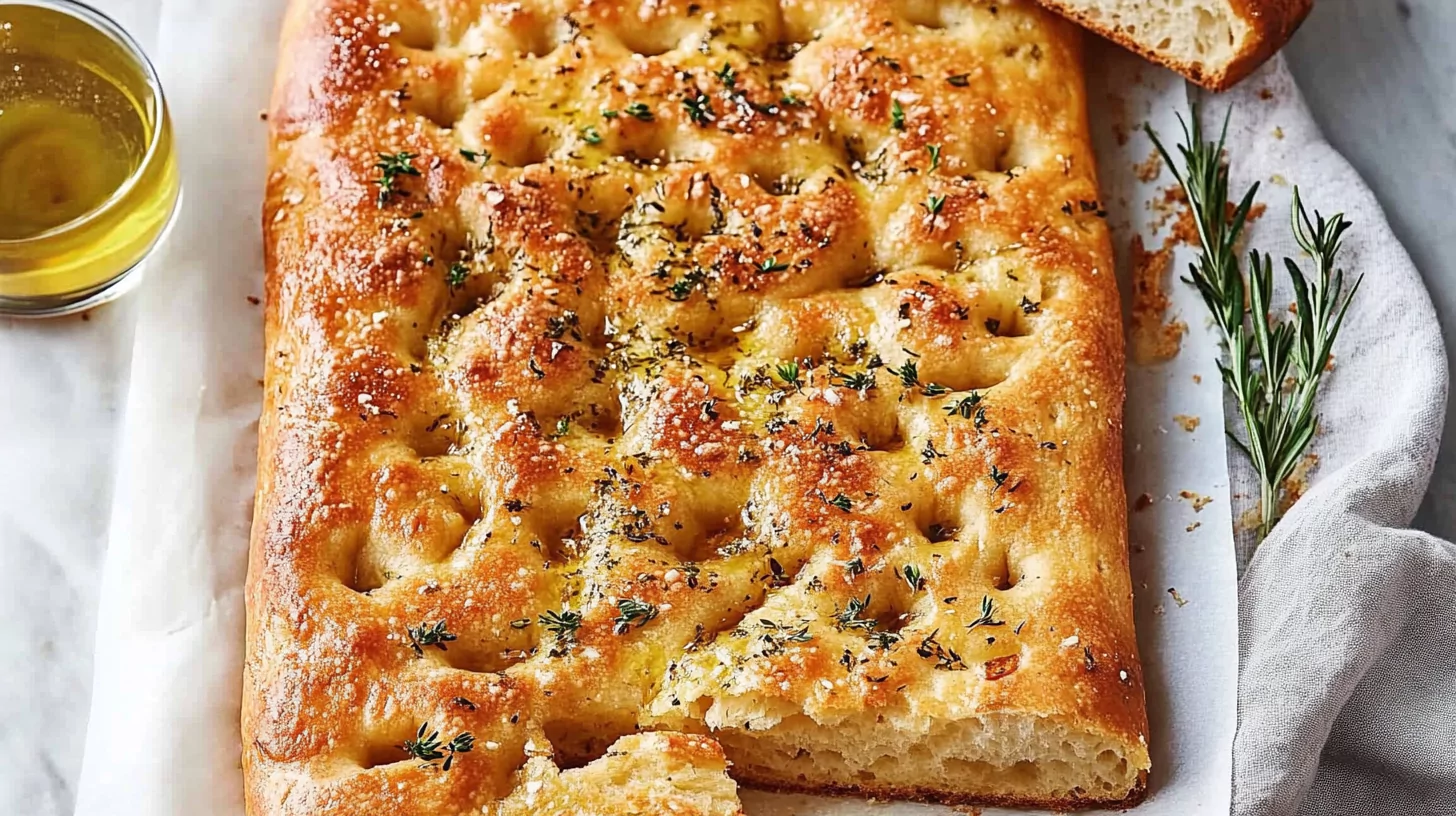
Overview of Focaccia Bread
Definition of Focaccia Bread
Focaccia bread is a delightful Italian flatbread that’s characterized by its soft, chewy texture and rich flavor, making it a staple in various culinary traditions. This versatile bread can be enjoyed plain, topped with various ingredients, or even served as a foundation for sandwiches. What makes focaccia stand out is its dimpled surface, which is often adorned with olive oil and a sprinkle of herbs, enhancing its already delicious taste.
I never knew how easy it was to make focaccia until I tried it at home! The key is using high-quality olive oil—it makes such a difference. My family can’t get enough of the golden crust and the soft, chewy texture. It’s now a regular on our dinner table! Sophia R.
Traditionally, focaccia bread is made from simple ingredients: flour, water, salt, olive oil, and yeast. Here’s a quick breakdown of its ingredients:
| Ingredient | Function |
|---|---|
| Flour | Provides structure |
| Water | Activates yeast |
| Salt | Enhances flavor |
| Olive Oil | Adds richness and moisture |
| Yeast | Causes the bread to rise |
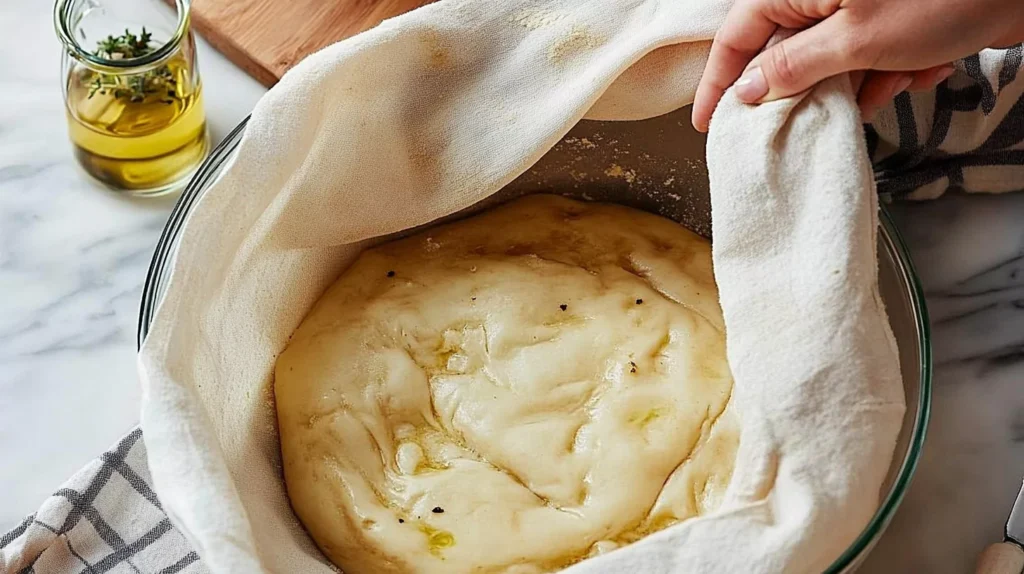
I fondly remember the first time I tried homemade focaccia bread at a friend’s house. The aroma wafting through the kitchen was irresistible, and it was almost magical how such simple ingredients could come together to create something so flavorful. The golden crust and the soft, airy interior were unlike any store-bought bread I had ever tasted.
Historical Background Of Focaccia Bread
The origins of focaccia trace back to ancient times, steeped in the rich culture of Italian cooking. Archaeological findings suggest that flatbreads have been enjoyed by various civilizations, including the Romans and Greeks. It is believed that the ancient Greeks prepared a precursor to focaccia known as “plakous,” which they topped with different seasonings and herbs.
As time progressed, the Italians embraced this flatbread tradition, and focaccia began to evolve. By the 16th century, the Romans had developed their version called “focaccia,” derived from the Latin word “focus,” meaning “hearth.” This connection to the fireplace symbolizes the communal nature of this bread, often baked in family kitchens and shared among loved ones.
Focaccia has various regional variations throughout Italy, reflecting the country’s diverse culinary heritage. Here are a few notable examples:
- Focaccia Genovese: Hailing from Genoa, this version is particularly known for its generous drizzling of olive oil and the addition of coarse salt, creating a flavorful crust.
- Focaccia Barese: Originating from Bari, this variation often includes potatoes in the dough, giving it a denser texture compared to its Genoese counterpart.
- Focaccia di Recco: This unique variant features a filling of creamy cheese between two thin layers of dough, showcasing the regional love for both bread and cheese.
As the Focaccia Bread spread beyond Italy, focaccia began capturing the hearts and palates of many across the globe. Today, you can find it in various forms in bakeries and restaurants, from gourmet establishments to casual eateries. It’s not just a side dish; people are creatively using focaccia as a base for pizzas or even turning it into delightful sandwiches.
In my personal experience, I love experimenting with toppings when making focaccia at home, from fresh rosemary and sea salt to sun-dried tomatoes and olives. Each ingredient contributes its magic, and the end result is always an explosion of flavor.
In conclusion, focaccia bread is more than just a flatbread; it’s a living tradition that embodies the rich history and culture of Italy. From its humble beginnings to its widespread popularity today, focaccia continues to bring people together, making any meal truly special. Whether you savor it at a rustic Italian trattoria or whip up a batch in your own kitchen, focaccia bread promises to deliver warmth, flavor, and nostalgia.
Nutritional Value of Focaccia Bread
As we explore the savory world of focaccia bread, it’s fascinating to delve into its nutritional profile. After all, while it’s a treat for the taste buds, understanding its macronutrient and micronutrient content can help us appreciate it even more in our diets.
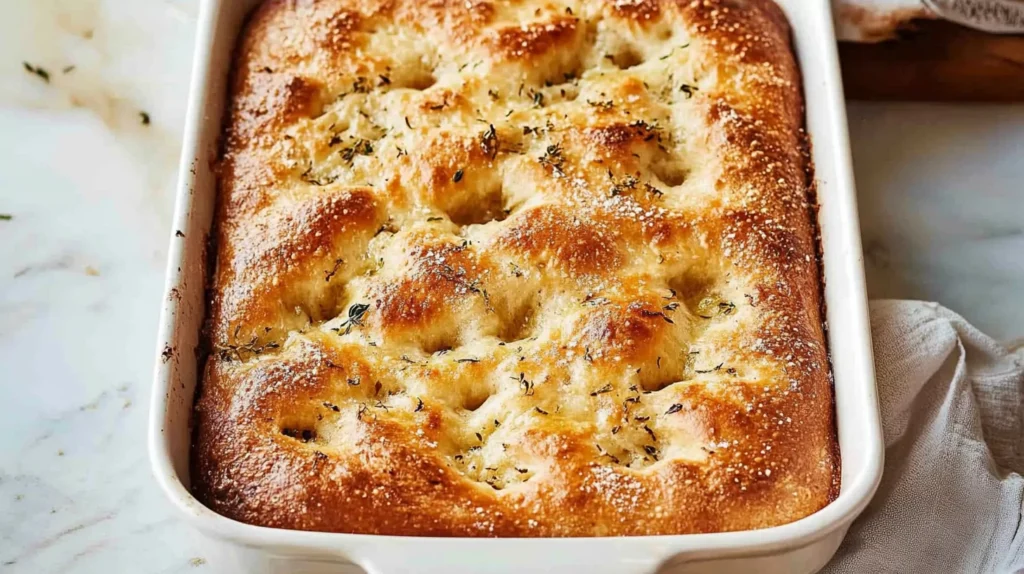
Macronutrient Content Of Focaccia Bread
Focaccia bread is primarily composed of carbohydrates, but it also includes a good mix of fats and proteins that contribute to its overall nutritional value. Here’s a basic breakdown of the macronutrient content per a standard serving (about 100g) of focaccia:
| Macronutrient | Approximate Amount per 100g |
|---|---|
| Carbohydrates | 44g |
| Protein | 8g |
| Fat | 7g |
- Carbohydrates: As a bread product, focaccia is rich in carbohydrates, primarily derived from the flour used. Carbs are essential for providing energy, particularly for muscle function during physical activity.
- Protein: With about 8 grams of protein per serving, focaccia provides a moderate amount of this vital macronutrient. Protein is crucial for muscle repair, immune function, and overall health.
- Fat: The healthy fats in focaccia come mainly from the olive oil used in the recipe. This not only adds to the flavor but also provides essential fatty acids, which are beneficial for heart health and inflammation reduction.
In my own kitchen, I’ve taken to making whole grain focaccia. It still offers that chewy texture, but with increased fiber content, which promotes satiety and aids digestion. It’s fun to experiment with healthier alternatives while still keeping the delicious essence of the original bread!
Micronutrient Content Of Focaccia Bread
While focusing on macronutrients is important, we must also consider the micronutrient value of focaccia bread. These are the vitamins and minerals that support our bodily functions on a smaller scale but are crucial for our health.
Some notable micronutrients found in focaccia include:
| Micronutrient | Function |
|---|---|
| Iron | Important for oxygen transport in blood. |
| Calcium | Vital for bone health and muscle function. |
| Magnesium | Supports muscle function and energy production. |
| B-vitamins | Aid in energy metabolism and brain health. |
- Iron: Focaccia can be a decent source of iron, especially when using whole grain flour. Iron is essential for transporting oxygen throughout the body, making it vital for stamina and overall energy.
- Calcium: Depending on the amount of cheese or other fortifying ingredients added, focaccia can contribute calcium, which is crucial for building strong bones and teeth.
- Magnesium: This mineral is often overlooked but plays a significant role in muscle function and energy production. Including focaccia in balanced meals can help increase your magnesium intake.
- B-vitamins: Essential for energy metabolism, B-vitamins can often be found in whole grain versions of focaccia. They support healthy brain function, mood regulation, and overall metabolism.
It’s fascinating to think about the nutritional content of something as simple yet versatile as focaccia bread. I’ve often found that by adding toppings like herbs, vegetables, or cheese, you can boost its micronutrient profile even further. For example, blending olives or fresh tomatoes can introduce additional healthy fats, vitamins, and antioxidants, making your focaccia not just a side dish but a well-rounded nutritional component.
In conclusion, focaccia bread is not only a delightful addition to any table but also a source of essential macronutrients and significant micronutrients. Whether enjoyed as a standalone treat, a sandwich base, or paired with meals, its nutritional profile can support a balanced diet while tantalizing your taste buds. The next time you indulge in a piece of focaccia, you can savor each bite a little more, knowing you’re also nurturing your body!
Health Benefits of Focaccia Bread
Now that we’ve explored the nutritional value of focaccia bread, let’s dive into some of its health benefits. It’s always refreshing to discover that what we love to eat can also be good for us. Focaccia bread, when enjoyed as part of a balanced diet, can offer potential advantages, particularly regarding heart health and digestive well-being.
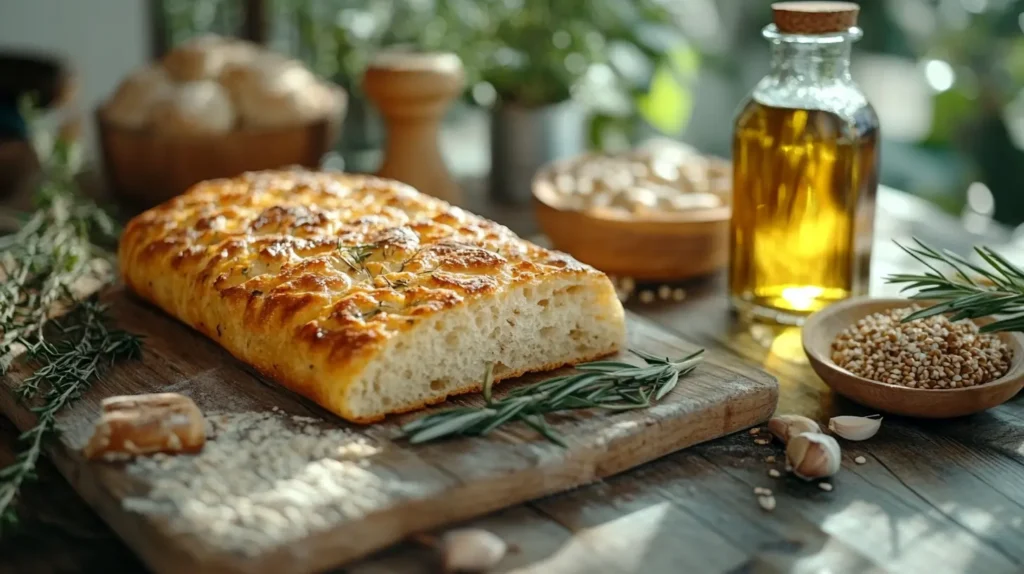
Potential Benefits Of Focaccia Bread for Heart Health
One of the standout features of focaccia bread, particularly when made with high-quality ingredients, is its potential benefits for heart health. Here’s how:
- Healthy Fats: The olive oil often used in focaccia is rich in monounsaturated fats, especially oleic acid. These healthy fats can help improve overall cholesterol levels. A balanced cholesterol profile lowers the risk of heart disease significantly.
- Antioxidant Properties: Olive oil is packed with antioxidants, including vitamin E and polyphenols, that combat oxidative stress in the body. This can lead to a reduced risk of cardiovascular diseases by protecting blood vessels and maintaining proper blood circulation.
- Whole Grain Variants: If you opt for whole grain flour when making focaccia, you’re getting a fiber boost. Dietary fiber is known to help reduce cholesterol levels, promote heart health, and control blood pressure. Incorporating whole grains into your diet plays a significant role in preventing heart disease.
I never thought focaccia could be part of a heart-healthy diet until I swapped in whole grains and used olive oil. The benefits are real—plus, the flavor is incredible. I now make it a regular in my meal rotation, knowing I’m getting the good fats my body needs. Samantha H.
I remember the first time I switched to whole wheat focaccia while experimenting with recipes at home. Not only did it retain that delightful chewy texture, but knowing I was also contributing positively to my heart health made each bite that much more enjoyable!
Furthermore, research suggests that a diet rich in whole grains can help lower inflammation within the body. Chronic inflammation is closely linked to various heart conditions, making focaccia, especially whole grain varieties, a wise choice in a heart-healthy diet.
Impact on Digestive Health Of Focaccia Bread
Another compelling reason to enjoy focaccia is its potential positive impact on digestive health, thanks to its fiber content and the use of wholesome ingredients.
- Fiber Content: As I mentioned earlier, opting for whole grain flour can significantly increase the fiber in focaccia. Fiber is essential for optimal digestive health, aiding in regular bowel movements and fostering the growth of beneficial gut bacteria.
- Gut-Friendly Ingredients: Many focaccia recipes include ingredients like herbs, garlic, or vegetables, which not only add flavor but also contribute dietary fiber and essential nutrients that support gut health. For example:
- Rosemary: Known for its anti-inflammatory properties, rosemary may help improve digestion.
- Garlic: A powerhouse for overall health, garlic can promote the growth of healthy gut bacteria.
- Improved Satiety: The combination of fiber and healthy fats in focaccia bread helps increase satiety. This means you’ll likely feel fuller longer, which can help you maintain portion control and prevent overeating.
The first time I tried homemade focaccia bred with rosemary and garlic, I was hooked. Not only did the flavor blow me away, but learning how much fiber and magnesium it provides made me appreciate it even more. It’s a bread that’s both delicious and nutritious! Daniel P.
I remember making a batch of focaccia topped with sun-dried tomatoes and rosemary, and the aroma was simply intoxicating. Not only was it delicious, but the fiber from the whole grains and toppings made me feel satisfied, which can be incredibly rewarding after a meal.
In addition, studies suggest that including a variety of fiber in your diet can help prevent digestive disorders such as constipation and diverticulosis. Regularly consuming fiber-rich bread like focaccia can promote a healthier gut, ultimately impacting your overall health positively.
In summary, focaccia bread is not just a delightful treat; it can be a friendly addition to a heart-healthy and digestive-friendly diet. The combination of healthy fats from olive oil, fiber from whole grains, and flavorful toppings contributes to its impressive health benefits. Enjoying focaccia mindfully and experimenting with its ingredients makes it a pleasure for both the palate and the body. So, the next time you savor a piece of freshly baked focaccia, appreciate not just the flavor but also the well-being it may bring!
Considerations for Healthy Focaccia Bread Consumption
While focaccia bread is undoubtedly delicious and offers various health benefits, it’s essential to approach its consumption wisely. Like any other food, moderation and mindfulness play crucial roles in enjoying focaccia without compromising your health goals. Here, we’ll explore important considerations regarding portion control and ingredients to watch out for.
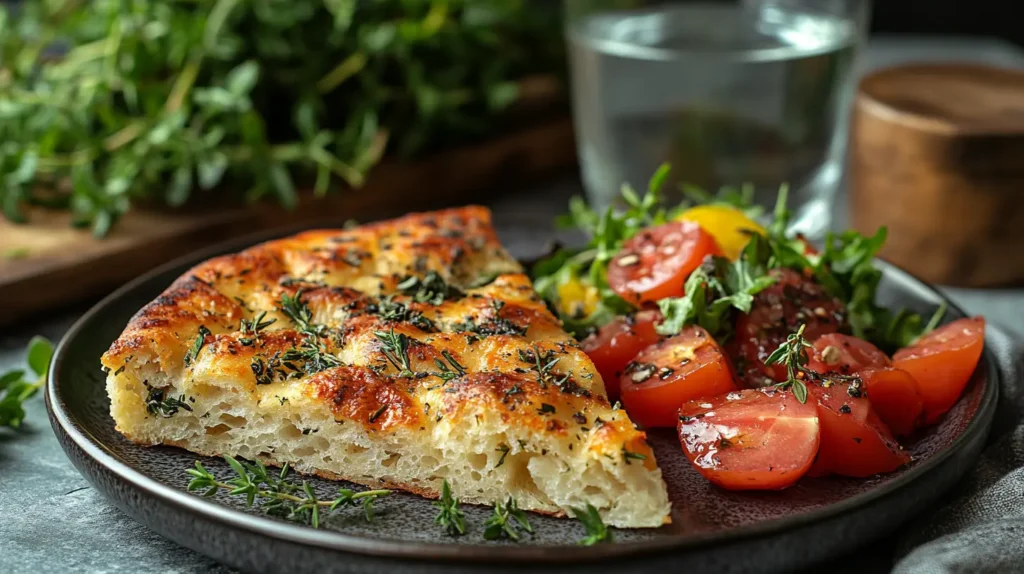
Portion Control
One of the simplest yet most effective strategies for healthy eating is practicing portion control. Focaccia can be quite tempting, especially when it’s fresh out of the oven, and it’s easy to lose track of how much we consume in one sitting. Here are a few tips to help you manage your portions effectively:
- Understand Serving Sizes: A standard serving of focaccia is about 100 grams (roughly a large slice). It’s helpful to be aware of this when you’re slicing into that warm loaf.
- Pre-portioning: Instead of carving away at an entire loaf, try cutting it into individual pieces right away. This simple step can help prevent mindless munching and allow you to enjoy one slice at a time.
- Pairing Wisely: Consider what you’re serving with your focaccia. Balancing it with healthy proteins and plenty of vegetables can help you feel fuller, making it easier to stick to one serving. For instance, enjoying a slice alongside a delicious salad or a hearty soup can create a well-rounded meal.
- Mindful Eating: Take the time to savor each bite. Eating slowly allows your body to register fullness better, reducing the chances of overeating. I’ve found that when I focus on the flavors of each ingredient, I not only enjoy the food more but also feel satisfied without needing to go back for seconds.
Over the years, I have learned that making focaccia a component of a larger meal—like a Mediterranean platter with olives, cheeses, and roasted vegetables—can provide variety and satisfaction without going overboard on calories.
Ingredients Of Focaccia Bread to Watch Out for
As delightful as focaccia can be, not all recipes are created equal. Here are some ingredients to be mindful of when enjoying or preparing focaccia bread:
- Refined Flours: Many traditional focaccia recipes use white flour, which, while incredibly delicious, lacks the fiber and nutrients found in whole grains. Opting for whole wheat flour can make your focaccia a more nutritious choice.
- Excessive Salt: Focaccia can sometimes be heavy on the salt, especially if topped with coarse sea salt. While salt enhances flavor, too much can contribute to high blood pressure and other cardiovascular issues. If you’re making it at home, try reducing the salt or using flavorful toppings (like herbs) to achieve that desired taste without overdoing it.
- Processed Additives: In commercial focaccia, you might encounter preservatives or artificial ingredients that aren’t present in homemade varieties. Always check ingredient labels if you’re purchasing ready-made focaccia. The fewer the ingredients, the better! Aim for ones that feature whole ingredients like olive oil, fresh herbs, and wholesome grains.
- High-Calorie Toppings: While toppings like cheese, olives, or cured meats can enhance the flavor, they can also significantly increase the calorie count. It’s best to be mindful of how many toppings you add. For a healthier version, try loading your focaccia with veggies, herbs, and lighter spreads instead.
Through my culinary adventures, I’ve discovered that experimenting with wholesome, fresh ingredients not only boosts the flavor of focaccia but also enhances its nutrition. Recently, I made a focaccia topped with cherry tomatoes, fresh basil, and a sprinkle of feta cheese—simple yet extraordinary in taste!
In conclusion, while focaccia bread is a treat that offers numerous health benefits, being mindful of portion control and ingredient choices is crucial. Enjoying focaccia in moderation, choosing whole grain options, and being aware of toppings will allow you to indulge while supporting your health goals. With these considerations in mind, you can truly savor every slice of Focaccia Bread without compromising your well-being. Happy baking (or buying) and eating!
Comparing focaccia Bread with Other Types of Bread
Now that we’ve delved into the health benefits and considerations surrounding focaccia bread, it’s time to widen our perspective and evaluate how focaccia stacks up against other popular types of bread. In this section, we’ll explore both the nutritional and health impact comparisons, helping us understand where focaccia fits into our diets.
Nutritional Comparison Of focaccia Bread with Other Types of Bread
The nutritional profile of bread can vary widely depending on ingredients and preparation methods. Let’s take a look at how focaccia compares to some common bread types: white bread, whole wheat bread, and sourdough.
| Type of Bread | Calories (per 100g) | Carbohydrates | Protein | Fat | Fiber |
|---|---|---|---|---|---|
| Focaccia (White) | 300 | 44g | 8g | 7g | 2g |
| White Bread | 265 | 49g | 9g | 3g | 2.4g |
| Whole Wheat Bread | 247 | 41g | 9g | 4.2g | 7g |
| Sourdough Bread | 289 | 56g | 9g | 1g | 1.9g |
- Calories: Focaccia tends to be higher in calories due to the olive oil used in its preparation, making it a more indulgent option compared to plain white or whole wheat bread.
- Carbohydrates: Focaccia and white bread have similar carbohydrate levels, but whole wheat and sourdough options offer a different composition, which can affect overall health.
- Protein: All the breads listed provide a reasonably comparable amount of protein, with whole wheat often taking the lead thanks to its higher nutritional content.
- Fat: Focaccia’s fat content is notably higher due to the olive oil, which is primarily healthy fat, while white bread typically contains very little fat.
- Fiber: Whole wheat bread stands out here with the most fiber, crucial for digestive health. Focaccia can vary based on whether whole grain flour is used, making it generally lower in fiber.
When I experimented with baking whole wheat focaccia at home, I discovered that not only did it retain its delightful flavor, but it also provided more fiber than the traditional white focaccia, making it a much more satisfying option.
Experimenting with whole wheat focaccia has been a game-changer for me. It’s satisfying, full of nutrients like iron and magnesium, and helps me stay full longer. Plus, it’s an easy way to sneak in some heart-healthy olive oil and still enjoy a comforting, indulgent treat! Emily K.
Health Impact Comparison
When considering the health impacts of different bread types, it’s essential to factor in how they contribute to factors like weight management, heart health, and digestive wellness.
- Weight Management: While focaccia offers great flavor, its higher calorie and fat content can lead to larger portions being consumed. In contrast, whole wheat bread, with its higher fiber content, can help keep you satiated longer. Personally, I’ve found that including whole grains in my diet makes it easier to manage weight, as it prevents the all-too-familiar cycle of hunger that can lead to snacking.
- Heart Health: Focaccia made with high-quality olive oil may support heart health due to the beneficial fats. However, the refined white bread options can be detrimental when consumed excessively, as they offer little in terms of nutrition or good fats. Whole wheat and sourdough breads are usually better choices if you’re looking to promote cardiovascular health.
- Digestive Health: The fiber content in whole wheat and sourdough is beneficial for digestive health, helping promote regular bowel movements and gut health. While focaccia does provide some fiber, it tends to be less than the other types unless made with whole grains. I’ve noticed that incorporating various types of bread into my meals keeps my digestion consistent, so variety truly plays a crucial role.
In conclusion, while focaccia bread is a delicious and versatile option, it does have a few nutritional considerations to weigh against other types of bread. Whole wheat bread may be more beneficial for digestive and heart health, while the indulgent appeal of focaccia lies in its rich flavor and texture. By becoming more aware of these comparisons, we can make informed choices that align with our health goals while still enjoying the delightful taste of focaccia. After all, it’s all about balance—indulging in your favorites while keeping health in mind is the key to a sustainable diet!
Print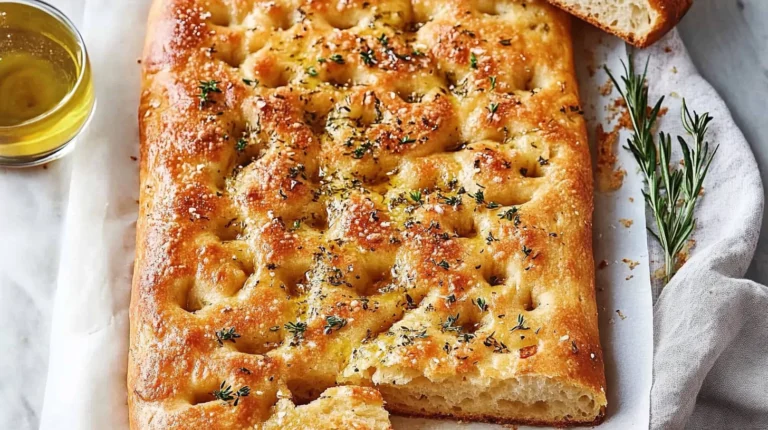
Is focaccia bread healthy?
Focaccia is a traditional Italian flatbread that’s soft, chewy, and versatile. It’s made with simple ingredients like flour, olive oil, and yeast, making it a perfect addition to any meal or as a standalone treat. Topped with herbs, garlic, or other ingredients, focaccia offers an aromatic and satisfying flavor experience. Whether served plain or as part of a sandwich, it brings warmth and comfort to the table.
- Total Time: 1 h 40 min
- Yield: 1 loaf 1x
Ingredients
- 500g all-purpose flour
- 325ml warm water
- 10g salt
- 15g dry yeast
- 60ml olive oil (plus extra for drizzling)
- 1 tsp sugar
- Fresh rosemary (optional)
- Coarse sea salt (for topping)
Instructions
- In a large bowl, combine warm water, yeast, and sugar. Let it sit for 5 minutes until frothy.
- Add flour and salt to the yeast mixture, then mix until dough forms.
- Knead the dough for about 10 minutes until smooth, then place in a greased bowl. Cover and let rise for 1 hour, or until doubled in size.
- Preheat oven to 220°C (425°F).
- Punch down the dough and roll it out into a baking pan. Use your fingers to make dimples in the dough.
- Drizzle with olive oil and sprinkle with fresh rosemary and coarse sea salt.
- Bake for 20-25 minutes or until golden and cooked through.
- Let cool slightly before slicing and serving.
Notes
- Experiment with different toppings such as olives, sun-dried tomatoes, or garlic for added flavor.
- For a whole grain version, substitute part of the all-purpose flour with whole wheat flour.
- The dough can also be prepared the day before; just refrigerate it overnight and let it rise before baking.
- Prep Time: 15 min
- Cook Time: 25 min
- Category: Bread
- Method: Baking
- Cuisine: Italian
- Diet: Vegetarian
Nutrition
- Serving Size: 1 slice (100g)
- Calories: 300
- Sugar: 1g
- Sodium: 600mg
- Fat: 7g
- Saturated Fat: 1g
- Unsaturated Fat: 6g
- Trans Fat: 0g
- Carbohydrates: 44g
- Fiber: 2g
- Protein: 8g
- Cholesterol: 0mg
